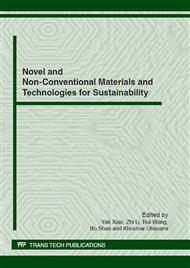p.771
p.776
p.784
p.791
p.797
p.801
p.809
p.817
p.824
Study on Silo Pressure by Consider Storage Materials Density Changed along the Height
Abstract:
The difference existed between results of silos pressure calculation and the actual case, because the influence of density stratification was not taken into consideration. The aim of this paper was to obtain silo pressure calculating formula by consider of storage materials density stratified. To this end, we assume that the density was continuous changed along the height and differential equation of the storage materials pressure was established. By compared the results calculated from the equation with the results calculated from the code, it is found that the maximum pressure increased. The results showed density stratified is an import factor for silo pressure calculation and the equation obtained in this paper can provide references for the theory of silo pressure calculation.
Info:
Periodical:
Pages:
797-800
Citation:
Online since:
June 2012
Authors:
Keywords:
Price:
Сopyright:
© 2012 Trans Tech Publications Ltd. All Rights Reserved
Share:
Citation:


